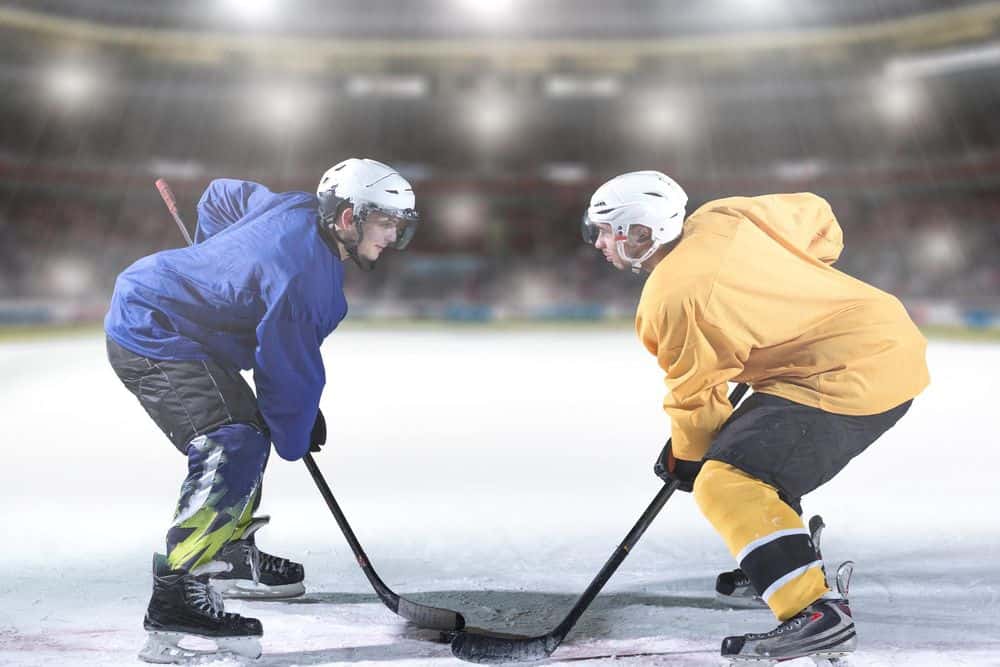Discover the exhilarating world of ice hockey, where the rush of gliding across the ice and the thunderous crack of a puck meeting the back of the net ignite a passion for the sport unlike any other.
In this article, we unveil the 10 epic reasons why ice hockey should be your top choice for an athletic pursuit.
From physical fitness benefits to the development of teamwork and communication skills, join us as we delve into the captivating realm of ice hockey and find your place on the ice.
Physical Fitness Benefits
Playing ice hockey offers numerous physical fitness benefits.
One of the key advantages is injury prevention. Ice hockey is a high-intensity sport that requires players to be agile and quick on their feet. This constant movement helps strengthen muscles and joints, reducing the risk of injuries.
Additionally, the fast-paced nature of the game promotes weight loss and muscle toning. Ice hockey is a great cardiovascular exercise that burns calories and builds endurance. The combination of intense skating, stickhandling, and shooting works various muscle groups, leading to improved strength and toning.
Furthermore, the sport helps improve balance and coordination, as players need to maintain stability on skates while handling the puck.
Teamwork and Communication Skills
Ice hockey fosters exceptional teamwork and communication skills among players, making it a sport that emphasizes collaboration and effective interaction on the ice. Here are four reasons why teamwork and communication are vital in ice hockey:
- Strategic Hockey Strategies: Teamwork allows players to execute complex hockey strategies effectively. By communicating with each other on the ice, players can coordinate their movements, anticipate plays, and create scoring opportunities. Effective communication ensures that everyone is on the same page, leading to a cohesive and well-coordinated team.
- Efficient Line Changes: Quick and efficient line changes are crucial in ice hockey. Players need to communicate effectively to ensure smooth transitions on and off the ice. By communicating their intentions and coordinating their actions, players can maintain the flow of the game and maximize their team’s performance.
- On-Ice Decision Making: Effective communication enables players to make split-second decisions during the fast-paced game. By quickly conveying information about the location of opponents, open teammates, and potential scoring opportunities, players can make informed decisions and execute strategies that lead to success.
- Building Trust and Camaraderie: Teamwork and communication foster trust and camaraderie among teammates. By relying on each other’s strengths, supporting weaknesses, and effectively communicating both on and off the ice, players develop strong bonds that enhance their performance as a team.
Sportsmanship and Respect
Hockey players exemplify sportsmanship and display respect towards their opponents through a time-honored tradition known as the handshake line. This tradition, which takes place after intense games, involves players from both teams lining up to shake hands and offer congratulations. It promotes good sportsmanship and teaches players to respect themselves and their opponents, regardless of the outcome of the game.
In addition to the handshake line, sportsmanship in youth hockey is emphasized and encouraged. Coaches, parents, and officials work together to create a positive and respectful environment for young players. This includes teaching them to respect the rules, their teammates, opponents, and officials. Respect for officials in ice hockey is crucial, as they play a vital role in ensuring fair play and enforcing the rules of the game. Players are taught to accept their decisions and maintain a respectful attitude towards them.
The following table illustrates the importance of sportsmanship and respect in ice hockey:
| Sportsmanship in Youth Hockey | Respect for Officials in Ice Hockey | Promotes fair play and respect for opponents | Ensures fair play and enforces the rules |
|---|---|---|---|
| Emphasized and encouraged | Crucial | Teaches players to respect themselves | Maintains a respectful attitude |
| Positive and respectful environment | Vital role | Encourages respect for the rules | Acceptance of decisions |
Sportsmanship and respect are values that are instilled in young hockey players and carried with them throughout their careers. By upholding these principles, players contribute to a positive and inclusive hockey community where everyone feels a sense of belonging.
Discipline and Humility
Players in ice hockey demonstrate discipline and humility by adhering to strict training regimens and maintaining a humble attitude both on and off the ice. Here are four reasons why these qualities are important in the sport:
- Importance of Discipline: Ice hockey requires players to commit to intense training sessions, showing up on time for practices and meetings, and taking care of their bodies through proper sleep and nutrition. This discipline not only improves their performance on the ice but also instills valuable habits that can be applied to other areas of life.
- Embracing Humility: In hockey, players learn to accept defeat and acknowledge the contributions of their teammates. They understand that goals are a team effort, and they appreciate the value of assists. By being humbled by opponents, players develop resilience and continue to work hard, always striving for improvement.
- Growth Mindset: Discipline and humility go hand in hand with a growth mindset. Players understand that there is always room for growth and that mistakes and setbacks are opportunities to learn and develop. They embrace challenges, seek feedback, and constantly work towards becoming better players and individuals.
- Building Stronger Teams: Discipline and humility foster a sense of unity and camaraderie among teammates. They create an environment where everyone is committed to the team’s success and supports each other’s strengths and weaknesses. This strong team dynamic leads to improved communication, trust, and ultimately, better performance on the ice.
Confidence and Personal Growth
Playing ice hockey can lead to significant personal growth and increased confidence for individuals of all ages and skill levels. The sport of ice hockey presents numerous challenges that players must overcome, both physically and mentally. It requires dedication, perseverance, and the ability to push through obstacles.
By continuously facing and conquering these challenges, players build resilience and develop a strong sense of self. Hockey teaches individuals to believe in themselves and their abilities, fostering a deep sense of confidence that extends beyond the rink. This newfound confidence can have a transformative effect on all aspects of life, empowering individuals to tackle challenges head-on and achieve their goals.
Through the game of ice hockey, players not only develop their skills on the ice but also grow as individuals, building resilience and confidence that will serve them well throughout their lives.
Coordination and Balance Enhancement
Through the sport of ice hockey, individuals can greatly enhance their coordination and balance skills, allowing them to excel not only on the ice but also in everyday activities.
Here are four reasons why playing ice hockey can improve coordination and balance:
- Improved reflexes: Ice hockey is a fast-paced game that requires quick reactions. Players must anticipate the movement of the puck and react accordingly, which enhances their reflexes.
- Hand-eye coordination: Hockey players must have precise control over their stick and puck. By constantly passing and shooting the puck, players develop excellent hand-eye coordination, which can transfer to other activities that require fine motor skills.
- Passing skills: Effective passing in hockey requires coordination between the hands and the eyes. Players must accurately time their passes and ensure the puck reaches their intended target, honing their coordination and balance.
- Skating balance: Skating on ice requires maintaining balance on thin blades. Hockey players develop strong core muscles and overall balance, which can benefit them in various physical activities off the ice.
Mental Toughness Development
Ice hockey cultivates mental toughness in players through the demanding and physically intense nature of the sport. The hockey mindset is built on resilience training, where players learn to overcome challenges, setbacks, and adversity.
In the face of aggressive opponents, injuries, and the pressure to perform, hockey players develop mental fortitude and the ability to stay focused and composed. The sport requires quick decision-making, adaptability, and the ability to handle high-pressure situations with confidence.
The hockey mindset instills discipline, determination, and a never-give-up attitude. Through practices, games, and competitions, players learn to push their limits, embrace discomfort, and develop mental strength.
The mental toughness developed in ice hockey not only benefits players on the ice but also translates into other areas of their lives, fostering personal growth and resilience in the face of life’s challenges.
Financial Considerations
The financial aspect of ice hockey is an important consideration for players and their families. Here are four key points to understand the cost implications and available financial assistance programs in ice hockey:
- Cost Variations:
- The cost to play hockey can vary depending on the level of play and location.
- Expenses include registration fees, equipment costs, and ice time fees.
- Additional costs may include travel expenses for tournaments and league fees.
- Average Expenses:
- On average, families can expect to spend several thousand dollars per year for a child to play hockey.
- This includes the costs mentioned above.
- It’s crucial to be aware of these expenses when considering participation in the sport.
- Financial Assistance Programs:
- To help reduce the financial burden, various financial assistance programs and equipment exchanges may be available.
- These programs aim to make ice hockey more accessible to players and families from diverse economic backgrounds.
- Seeking Support:
- It is important to research and reach out to local hockey associations, community organizations, and governing bodies to inquire about available financial assistance programs.
- These programs can provide valuable support to ensure that ice hockey remains an inclusive and affordable sport for all who wish to play.
Stanley Cup Bonus
Stanley Cup winners receive a substantial bonus as a reward for their victorious achievement in the sport of ice hockey. The bonus is a significant financial incentive that recognizes the hard work, dedication, and skill required to win the championship. The salary distribution among the players varies depending on the team’s internal agreement, but each member of the winning team receives a generous share.
The Stanley Cup, often referred to as the Holy Grail of hockey, represents the pinnacle of success in the National Hockey League (NHL). It is a testament to the players’ perseverance and commitment to the sport. The bonus not only provides financial security but also serves as a symbol of the players’ accomplishment.
Championship celebrations are often extravagant, with players and their families enjoying the fruits of their labor. The Stanley Cup bonus is a well-deserved reward for the players’ exceptional performance and serves as a reminder of their triumph for years to come.
Miscellaneous Hockey Information
Continuing our exploration of ice hockey, let’s delve into various aspects of the sport that fall under the category of miscellaneous hockey information.
- Hockey Equipment: To play ice hockey, players need specific equipment such as skates, a stick, helmet, shoulder pads, and gloves. These items ensure safety and enhance performance on the ice.
- NHL Overtime Rules: In the National Hockey League (NHL), overtime rules differ between the regular season and playoffs. During the regular season, if the game is tied after regulation time, a five-minute sudden death overtime period is played. If no team scores, the game enters a shootout. In the playoffs, a 20-minute sudden death overtime period is played until a team scores, determining the winner.
- National Hockey League (NHL): The NHL is the premier professional ice hockey league in North America. It consists of 32 teams, known for their skill, passion, and dedication to the sport. The NHL showcases the highest level of competitive ice hockey and serves as a source of inspiration for players and fans alike.
As we explore miscellaneous hockey information, it becomes clear that understanding the required equipment, NHL overtime rules, and resources like Ultimate Indoor Sports are essential for fully immersing oneself in the thrilling world of ice hockey. From the equipment that provides protection and enhances performance to the rules that determine the outcome of intense matches, these aspects contribute to the overall experience of this captivating sport.
Frequently Asked Questions
How Much Does It Cost to Play Ice Hockey?
The cost to play ice hockey varies depending on the level of play and location. Expenses include registration fees, equipment costs, and ice time fees. Families can expect to spend several thousand dollars per year, but financial assistance programs and equipment exchanges may be available to help reduce costs. Ice hockey equipment, such as skates, sticks, helmets, shoulder pads, and gloves, is essential for players. The National Hockey League (NHL) is the premier professional ice hockey league in North America.
What Are the Rules for NHL Overtime in the Regular Season and Playoffs?
In NHL overtime, teams play with fewer players, creating a fast-paced and intense environment. The rules differ between the regular season and playoffs, with strategies for winning including aggressive play and capitalizing on scoring opportunities. Overtime can greatly impact player stats.
What Is a Good Save Percentage in Hockey?
A good save percentage in hockey is a crucial statistic for goaltenders. It measures the percentage of shots on goal that are successfully saved. A high save percentage indicates strong goaltending skills and contributes to the team’s success.
What Are the Best Positions for Beginners in Hockey?
The best positions for beginners in hockey are forward, defense, and goalie. To excel, beginners should focus on acquiring essential skills such as skating, stickhandling, and shooting. Proper equipment, including skates, sticks, and helmets, is crucial for their development.
How Cold Is It in a Hockey Rink During Games?
During hockey games, rinks are typically kept at temperatures around 45 to 55 degrees Fahrenheit. Players must wear appropriate equipment, such as thermal undergarments, insulated gloves, and warm hats, to stay warm and prevent frostbite.
Conclusion
In conclusion, ice hockey offers a plethora of physical, mental, and personal benefits that make it an exceptional sport for individuals of all ages and skill levels.
From the high-intensity interval training and cardiovascular exercise to the development of teamwork, communication, and sportsmanship skills, hockey provides a comprehensive package of advantages.
Moreover, the sport instills discipline, humility, and mental toughness, fostering valuable life lessons beyond the rink.
With its transformative impact on confidence and personal growth, ice hockey truly stands out as a captivating and rewarding athletic endeavor, like a symphony of determination and grace.









